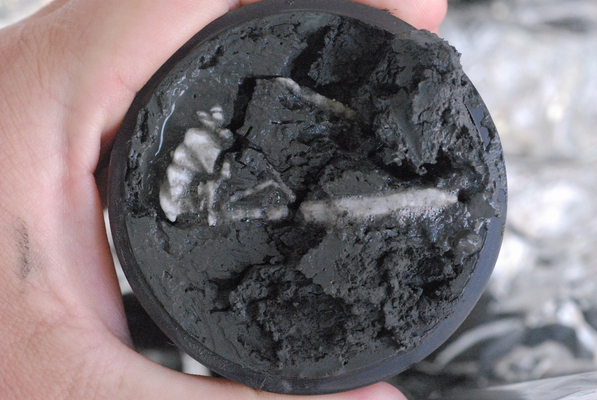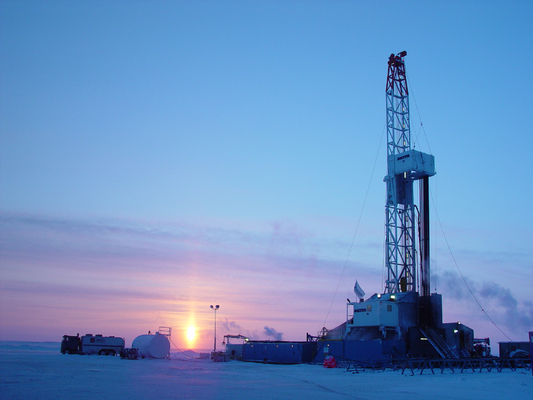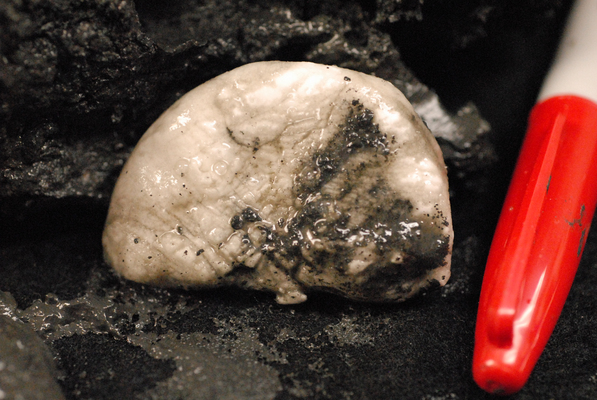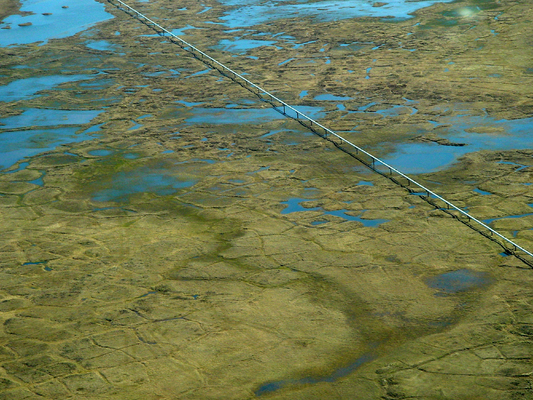
by Nicole Branan Thursday, January 5, 2012

Sediment cores reveal hydrates (the white part of the core). An estimated 17 trillion cubic meters of natural gas as methane hydrates are stored beneath the North Slope. U.S. Geological Survey

In the Canadian Arctic, scientists are testing whether methane production through depressurization is feasible. U.S. Geological Survey

A chunk of methane hydrate. U.S. Geological Survey

One concern about depressurizing methane hydrates in the North Slope is that it could cause the marshy ground to collapse under the weight of production infrastructure. Dave Houseknecht, U.S. Geological Survey
Buried beneath the gigantic swath of desolate tundra that forms Alaska’s North Slope are some of the nation’s biggest hydrocarbon resources. For decades, the Trans-Alaska Pipeline has supplied about 20 percent of the nation’s oil. But below the permafrost of the Last Frontier lies another huge fossil fuel resource — and this one is a lot harder to tap.
An estimated 17 trillion cubic meters of frozen methane, or natural gas, are stored beneath the North Slope, locked away in vast arrays of tiny ice cages. These methane hydrates form within deeply buried sand layers, in which each individual methane molecule is trapped inside a small crystalline structure made of frozen water. Getting the gas out of these reservoirs safely and efficiently is a dream of energy companies, but the potential production methods so far all involve liquefying the hydrates, which poses technical problems and serious risks.
Now a field trial planned next winter in Alaska’s Prudhoe Bay area will test a different approach: Rather than destroying the hydrates to release the gas, the new technique relies on pumping carbon dioxide into the fields to replace the methane and keep the ice structures intact. If successful, the approach will not only keep the hydrate reservoirs mechanically stable, but will also sequester large quantities of carbon dioxide in the process.
Right now, no extensively tested technologies exist to exploit methane hydrates. But if scientists and engineers can find a successful technique, it could open up a new avenue to extract methane from hydrate deposits all over the world. The potential is enormous: The estimated amount of technically recoverable methane from hydrates beneath Alaska’s North Slope alone would be enough to heat more than 100 million average homes for about 10 years, according to the U.S. Geological Survey. The amount of methane stored in permafrost and seafloor hydrate deposits worldwide could be more than twice as much as all other fossil fuel resources combined, estimates suggest.
So far, the furthest a potential production method has come was a six-day test in Canada’s Mackenzie Delta, where teams of scientists and engineers opened up a tiny section of a hydrate reservoir to release the pressure, thereby melting the hydrates and producing the gas.
But doing this on a larger scale can be risky because methane might leak and the procedure could destabilize the ground, reducing its ability to support equipment. “You can almost envision this as being analogous to the changes that occur when you warm up the permafrost in the Arctic in the summer,” says Charles Paull, a senior scientist at the Monterey Bay Aquarium Research Institute in Moss Landing, Calif. In the winter, he says, there is no problem with supporting foundations for drill pads, “but once the seasonally frozen area diminishes, you discover that you are on something that is akin to marsh” that would not support such infrastructure.
The approach that will be tested next winter is based on an observation that scientists have known about for some time: When carbon dioxide molecules are introduced into the icy methane hydrates, methane tends to spontaneously leave the cages and carbon dioxide immediately fills the voids. However, early experiments in which researchers dunked chunks of methane hydrate in tanks filled with liquid carbon dioxide suggested that this exchange happens extremely slowly. “A few millimeters an hour was typical in these experiments,” says Ray Boswell, technology manager at the U.S. Department of Energy’s National Energy Technology Laboratory methane hydrates program, based in Morgantown, W.Va. At that rate, it would take decades to push the methane out of the hydrate fields.
A few years ago, researchers at ConocoPhillips and the University of Bergen in Norway took a second look at the carbon dioxide-methane exchange technique. Instead of using isolated chunks of pure hydrate, they focused on hydrates in the pore spaces of sandstone, similar to conditions found in nature. They then exposed those sandstone-encased hydrates to carbon dioxide. When they cooled and squeezed these samples to the temperatures and pressures that exist in the underground of Alaska’s North Slope, they saw much faster exchange rates. The lab results looked so promising that the U.S. Department of Energy and ConocoPhillips decided to test the technique in the field.
Next winter, they plan to truck a load of liquefied carbon dioxide out to Prudhoe Bay, drill into a hydrate reservoir, and do what in industry lingo is called a “Huff and Puff” — inject some liquid into a well, let it soak, and then draw the fluids back and see what comes out, Boswell says. The objective of the initial 30-day field trial is mainly to get preliminary results that could allow them to extrapolate what a larger project could yield, he says.
Magnetic Resonance Imaging data from lab experiments indicate that this technique keeps the hydrates in their frozen form throughout all stages of the exchange reaction. That means that the physical properties of the reservoir won’t change, so “you have less potential for sand grains to flow along with the water and the gas,” Boswell says.
That also eliminates the need to deal with water at the surface, which is another significant advantage, says Timothy Collett of the U.S. Geological Survey in Denver, Colo. That saves energy: Any produced water has to be pumped out of the reservoir. “In any production scenario, you have to lift water out of the well; it doesn’t flow naturally,” Collett says. The water that forms the hydrates themselves is pure, and could even be viewed as a commodity, but other formation waters that contain salts and other impurities would likely be produced with it, he says. Thus, disposing of the produced water in a permitted way is usually expensive.
But the biggest advantage of the carbon dioxide-methane exchange technique might be the carbon sequestration aspect, Paull says. For every methane molecule that gets pushed out of its cage and brought to the surface, one carbon dioxide molecule gets trapped underground. That means that “the process would be greenhouse gas-neutral, and in the energy business that is about as good as it gets,” he says.
Although the exchange ratio is one to one, whether the greenhouse gas balance ends up being truly neutral depends on where the carbon dioxide comes from. For example, one possible scenario of a future commercial-scale methane extraction from hydrates in Prudhoe Bay involves using carbon dioxide that wouldn’t have ended up in the atmosphere in the first place, Boswell says: An estimated trillion cubic meters of so-called stranded gas — conventional natural gas that hasn’t been produced yet because of the lack of a pipeline to carry it to markets far away — are buried in Alaska.
This gas is laced with 10 to 12 percent carbon dioxide, which future producers would have to strip off if they produced it. Pumping this carbon dioxide directly into methane hydrate fields would be a convenient way to get rid of it, Boswell says. That is only an issue if the gas is actually extracted in the first place, but it means that methane production from hydrates “would use carbon dioxide that was already sequestered.”
Another question is how much of the carbon dioxide would actually be trapped, Paull says. If part of the gas moves into the hydrate formation but doesn’t actually get locked into the ice cages, then it may not stay there for very long. “I don’t know whether these rather shallow gas hydrate deposits are the place where you would want to have huge flows of carbon dioxide in the ground because they may not be well-sealed,” he says. “If you put carbon dioxide into the ground, you want it to stay there for geologic time; otherwise you have accomplished nothing.”
But those carbon dioxide molecules that do get trapped in hydrate cages will be securely stored away. Lab experiments even suggest that carbon dioxide hydrates are more stable than their methane counterparts, so filling the reservoirs with carbon dioxide could even be an advantage in a future where climbing temperatures might thaw the permafrost, Boswell says.
At this point, these questions are still academic, because the technique is still in the very early stages of testing, Boswell cautions. And the jump from tightly controlled, idealized conditions in the lab to the real world is always a large one, he adds.
One of the biggest questions is how quickly carbon dioxide will infiltrate the reservoir and how quickly the exchange will happen. Flow rates will have to be “such that this would be doable on a commercial scale,” Boswell says. A number of other things, such as free water that might be sitting in the reservoir, could “throw in a monkey wrench as well,” he says. “For example, when this water sees the carbon dioxide, it might form hydrate,” he says. If some carbon dioxide is gobbled up that way, it won’t even get a chance to trade places with the methane in the already-buried hydrate cages.
Another issue might be the efficiency of the actual exchange. Producing methane from hydrate through depressurization should, at least in theory, release every single trapped methane molecule. The carbon dioxide-methane exchange, on the other hand, may release only some of them. That’s due to the hydrate structure, Boswell says. Each gas hydrate cage basically looks like a sponge, with two different sizes of holes. While a methane molecule fits comfortably in both, carbon dioxide only fits well into the bigger cage. Therefore, he says, carbon dioxide may not drain both sizes of voids.
Although the concept of producing methane from hydrates by exchanging it for carbon dioxide is “fascinating,” whether it will actually turn out to be a viable production technique remains to be seen, Paull says. “The idea is exciting and the initial data on the topic are tantalizing, but the proof that this will work is probably going to be harder to pull off.”
© 2008-2021. All rights reserved. Any copying, redistribution or retransmission of any of the contents of this service without the expressed written permission of the American Geosciences Institute is expressly prohibited. Click here for all copyright requests.